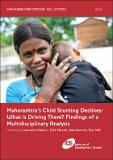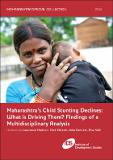| dc.contributor.author | Haddad, Lawrence | |
| dc.contributor.author | Nisbett, Nick | |
| dc.contributor.author | Barnett, Inka | |
| dc.contributor.author | Valli, Elsa | |
| dc.coverage.spatial | India | en_GB |
| dc.date.accessioned | 2014-08-05T11:05:31Z | |
| dc.date.available | 2014-08-05T11:05:31Z | |
| dc.date.issued | 2014-08-05 | |
| dc.identifier.isbn | 978 1 78118 179 9 | |
| dc.identifier.uri | https://opendocs.ids.ac.uk/opendocs/handle/20.500.12413/4254 | |
| dc.description.abstract | Between 2006 and 2012, Maharashtra’s stunting rate among children under two years of age was
reported to decline by 15 percentage points – one of the fastest declines in stunting seen anywhere
at any time. This was seemingly more remarkable because it occurred within a context where Indian
stunting levels nationally are regularly characterised as stuck or static. Maharashtra, the second
largest state in India with a population of over 100 million people, appears to represent a major
departure from the norm. This report aims to understand the driving factors behind this rapid decline.
The report draws on three source papers written by the authors, which are summarised in this
overview paper: one drawing on secondary data (section 2 – Haddad 2014), one drawing on
primary survey data (section 3 – Haddad and Valli 2014) and one drawing on primary qualitative
data (section 4 – Barnett and Nisbett 2014).1 As will become clear, the three papers, using different
methods and written by different combinations of the three principal authors, arrive at very similar
conclusions, giving us greater confidence in their validity.
This overview first surveys the literature to describe the broad economic, political and social
changes occurring within the state in the 2000–2012 period. In what kind of environment did these
declines in stunting occur? Second, the paper analyses two child-level surveys undertaken in
2006 and 2012 to describe the distribution of stunting declines, identify factors correlated with the
higher stunting (and wasting) rates in both years and to assess whether the relationship between
stunting, wasting and its correlates has profoundly changed. Third, we conducted interviews and
focus group discussions with key stakeholders in academia, civil society, government, international
partner organisations, media and the private sector to identify the perceived critical factors for the
decline in stunting. The final section of the paper concludes with a series of messages that we
believe are important for nutrition policymaking in India and globally. | en_GB |
| dc.language.iso | en | en_GB |
| dc.rights | This publication is copyright, but may be reproduced by any method without fee for teaching or nonprofit purposes, but not for resale. Formal permission is required for all such uses,
but normally will be granted immediately. For copying in any other circumstances, or for re-use in other publications, or for translation or adaptation, prior written permission must be obtained from the publisher and a fee may be payable. | en_GB |
| dc.rights.uri | http://www.ids.ac.uk/files/dmfile/IDSOpenDocsStandardTermsOfUse.pdf | en_GB |
| dc.subject | Nutrition | en_GB |
| dc.title | Maharashtra’s Child Stunting Declines: What is Driving Them? Findings of a Multidisciplinary Analysis | en_GB |
| dc.type | Other | en_GB |
| dc.rights.holder | Institute of Development Studies and UNICEF | en_GB |
| dc.identifier.team | Vulnerability and Poverty Reduction | en_GB |


